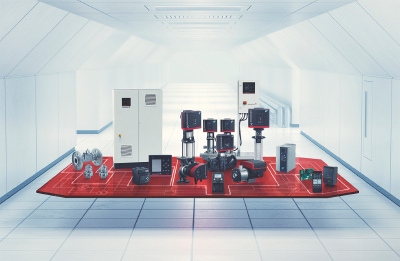Pump and system in harmony
The pumps used in building-services system today are both much more efficient and controllable than older pumps. In addition, many installed pumps are oversized. All-in-all, there are lots of opportunities for reducing the energy used by pumps and improving the efficiency of the systems they serve, as David Considine of Grundfos Pumps explains.
Much has been written over recent years to both raise the profile of reducing energy consumption whilst explaining the benefits of doing so. This debate is now backed by a variety of legislation and has had a significant amount of wordage written relating to commercial building-services buildings and products, which, of course, includes pump solutions.
We say ‘of course’ because we know that pumps are big energy consumers that currently account for 10% of global electricity and that many are needlessly inefficient. In fact by focusing on changing to high-efficiency pumps that incorporate advanced motor technology, companies can reduce the average pump’s energy consumption by up to 60%.
This is no longer simply a moral argument, but one that has significant environmental and financial importance.
What value should we place on efficiency?
To explain a little about how efficiency is a function of good pump design and not purely a standalone benefit, it is important to understand the true value of pump efficiency — or wire-to-water efficiency.
An easy way to place a value on efficiency is to discuss operating costs. That approach is looked at here, but it should also be noted that operating costs (which reflect power draw) have a direct link to power generation and environmentally disturbing factors (such as greenhouse gasses).
Simply stated, pump efficiency is the ratio of output power divided by the input power, expressed as a percentage.
Efficiency in pumps, as portrayed on pump curves or stated on pump data sheets, is a calculated value based on test results. The amount of work being done is measured, as is the power consumption by the pump; efficiency is calculated from those results.
Many factors affect pump efficiency, but there are three stand-out components.
• Mechanical efficiency. This is the energy used in bearings, stuffing box/glands and disc friction losses at the wear rings.
• Volumetric efficiency. This accounts for recirculation and turbulence and other losses at glands.
• Hydraulic efficiency. This accounts for friction and shock losses in the flow paths.
When does a pump achieve ‘high-efficiency’ status?

It is difficult to state what is meant by high efficiency in a pump. The variety of pump types and intended duties, the specific speeds, pump size, etc. are so varied, that no figure can be set that encompasses these circumstances. However, the following can be assumed.
• In general, the larger the pump, the higher the attainable efficiency.
• Efficiency should be relative to other, similar, pumps of the same size and type.
• Efficiency is only one aspect of pump performance, and reliability should not be sacrificed for efficiency improvements. Typically, when efficiency is discussed, it refers to efficiency at either the best efficiency point (BEP) or a given operating condition. It is not helpful to look at a pump with 90% efficiency at design point and hear, ‘Look how efficient this pump is,’ if the point of selection is not at that point.
• While efficiency of the pump is important, its impact is best totally evaluated by a study of the system in which it is installed. Moving a pump to its BEP by closing valves and balancing a system will indeed improve its efficiency, but the system itself may become even more inefficient or, worse, less effective and is something we have seen happening in the UK for many years.
This means that to achieve the highest overall efficiency the total system needs to be looked at in terms of the entire system, as opposed to just viewing the pump in isolation.
Looking beyond the pump
Today we are all aware that there is increasing pressure on margins at every point in the value chain. Therefore being able to deliver real energy savings with a short return on investment, less than two years for example, is now a necessity.
By thinking beyond the pump and taking the entire pumping system into account, it is possible to optimise the way pumps, drives, controls and protection, measurement and communication units work together as part of one system. A manufacturer can incorporate specific demands with its application expertise and then take these requirements and translate them into state-of-the-art pump intelligence — for any application. This approach considers the entire system.
There are many benefits to adopting such an approach. One is the obvious savings that will be achieved through improved efficiencies. However, ensuring that pumps, controls, sensors, variable-frequency drives, connectivity and software are fully aligned means these solutions offer the optimal result.
The need to optimise and control speed is something that will continue to gain in importance within building services, so the potential for systems to become increasingly synchronised will continuously play a more major role.
David Considine is product manager with Grundfos Pumps.








